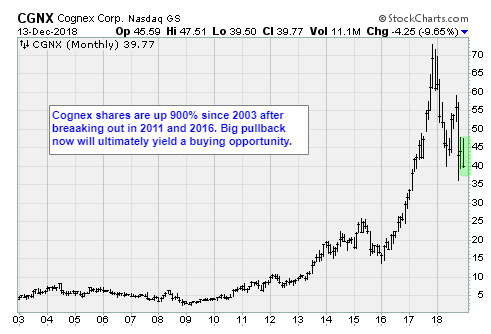Disruptive Farmers Grow a New Ag Business Model
Note: Jon’s taking a well-deserved break starting next Monday. He’ll resume his regular Monday-Wednesday-Friday publication schedule after the holidays on Wednesday, Jan. 2.
The world is going to run out of food.
Don’t worry, the best minds are on it. They are using better seeds, lighting and irrigation systems to reimagine farming. They are also using robots. And this has attracted the attention of, not to mention funding from, several high-profile humans.
Bowery Farming Inc. calls its process “precision farming.” According to a report from Bloomberg, the indoor agriculture technology company is about to secure $90 million in funding.
It is a larger opportunity for investors with vision.
Like many technology startups, Bowery founders are determined to solve the big problems confronting the world. The United Nations projects that the world population will swell to 10 billion people by 2050. To keep up, global farmers will have to produce 70% more food.
Unfortunately, there is not enough water or land to possibly meet future demand.
Most of the world’s water resources are used for food production. And 30% of arable agricultural land has been lost to poor planning, pesticides and urbanization.
So, Bowery engineers set out to do more with less.
The solution began with controlling as many variables as possible.
- Crops are grown indoors under ideal conditions, without pesticides.
- Complex LED lighting mimics the full spectrum of the sun.
- Irrigation systems deliver nutrients with exact specificity, resulting in 95% less water use than traditional farming and a 100x improvement in crop yields.
This urban farm company is using all the tools of modern technology — robotics, machine learning, computer vision and data science — to fine-tune the entire process.
Bowery is not the only company in the game. Last year, indoor farm company Plenty made headlines when it secured $200 million in financing from Softbank, the Japanese firm led by billionaire Masayoshi Son, and investment companies associated former Alphabet chairman Eric Schmidt and Amazon founder Jeff Bezos.
Related post: This start-up is planting the seeds to disrupt farming for good
The gigantic investment in the tiny San Francisco startup sent shockwaves through the burgeoning ag-tech community. Early investors understood the potential of marrying sensors, robotics and data science with agriculture. The Softbank vote of confidence underscored the urgency.
Bowery’s latest $90 million round was led by GV, the new name of Google Ventures.
Alphabet, the parent company of Google, has made a cottage industry out of developing business models around machine learning. Its investment in Bowery is on-brand.
Farming has not changed much in centuries. Yes, there are now self-driving tractors and even drones to monitor the growing process. But the basic premise still involves sowing seeds and waiting patiently for Mother Nature to bless the soil with bountiful crops.
Companies like Bowery and Plenty completely disrupt that notion.
They want to control every aspect of the growing environment. They are cutting Mother Nature out of the loop to reduce costs, speed up growing cycles and reduce the footprint of farms.
This is a revolution made possible by automation, better information and data science.
Even five years ago, the economics of this revolution did not make sense. However, falling prices for cloud computing, robotics, sensors and machine learning have opened new doors. Information technology is being commoditized — just like fruits, vegetables and livestock.
Cognex Corp. (CGNX) is the leading maker of sensors and vision systems for smart, industrial robots.
For a long time, truly smart machines were a pipe dream. Robots were impressive for their might. They stamped or welded or pushed items along a precision conveyor belt. But they were dumb. They didn’t have eyes. They could not make sense of their place in the process.
The Cognex Insight Vision system gave industrial robots eyes. Machine learning and better software systems gave them intelligence. These attributes that are in high demand as factories get smarter, and ambitious start-ups push the limits of ag-tech.
The Massachusetts company has an impressive history of growth. Since 2013, sales are up 2.2x to $748 million. During fiscal 2017, the last full year of financial data, revenues shot up 43.5% while income ballooned 18% to $177 million.
These metrics are certain to increase as more industrial robots gain sight, and smarts.
Related post: Artificial intelligence is starting to smart
Cognex shares have been cut in half amid concern about the health of the global economy. The stock has fallen from a high $73 in October 2017 to the lower $40s, bringing the market cap to only $7.2 billion.
At 29x forward earnings, Cognex shares are still expensive, but not ridiculous for a unique, patent-protected, cutting-edge tech company in a growing field.
Longer-term investors with vision could use weakness in the weeks ahead to establish positions.
Best wishes,
Jon D. Markman




